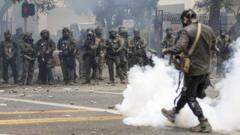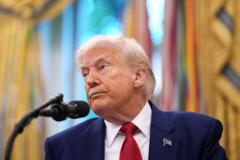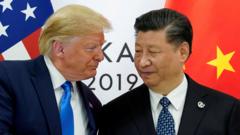The situation surrounding immigration raids in Los Angeles has ignited significant unrest, prompting President Trump to send 2,000 National Guardsmen to the area to maintain order. The deployment comes after clashes between federal agents from Immigration and Customs Enforcement (ICE) and local residents, primarily from Latino neighborhoods.
National Guard Deployed to LA Amid Immigration Raids Unrest

National Guard Deployed to LA Amid Immigration Raids Unrest
President Trump's decision to deploy the National Guard in Los Angeles following immigration raid protests raises questions over authority and local governance.
Tensions escalated as demonstrators protested against the aggressive tactics used by ICE, resulting in numerous arrests and the use of tear gas by riot police. California Governor Gavin Newsom condemned the raids, criticizing them for being inhumane and detrimental to the community. Authorities reported that this week, ICE conducted operations leading to over 100 detentions, setting the stage for confrontations fueled by anger over immigration policies.
Tom Homan, the administration's immigration enforcement chief, defended the ICE operations, emphasizing their necessity for public safety. He noted that lawlessness resulting from protests necessitated bringing in the National Guard. The administration characterized the deployments as a critical response to protect citizens amidst violence against federal agents.
Critics of the federal government's actions argue that this approach is incendiary and threatens local governance. Governor Newsom labeled Trump's mobilization a tactical misstep, positing that regional leaders should manage such situations. Los Angeles Mayor Karen Bass echoed this sentiment, accusing ICE of instilling fear within the community rather than fostering safety.
Through social media, Trump rebuffed local leaders, suggesting federal intervention was required due to their inability to maintain order. Amidst this turmoil, advocates for immigrant rights have decried the raids as terrorizing vulnerable communities, mobilizing grassroots rallies to demand an end to such operations.
As this conflict unfolds, the balance between securing borders and upholding community trust remains a contentious focal point, revealing deep divisions within American society over immigration policy and federal authority.
In conclusion, the deployment of the National Guard in response to protests over immigration raids reflects a broader national discourse on how to address issues of migration and law enforcement within local communities.
Tom Homan, the administration's immigration enforcement chief, defended the ICE operations, emphasizing their necessity for public safety. He noted that lawlessness resulting from protests necessitated bringing in the National Guard. The administration characterized the deployments as a critical response to protect citizens amidst violence against federal agents.
Critics of the federal government's actions argue that this approach is incendiary and threatens local governance. Governor Newsom labeled Trump's mobilization a tactical misstep, positing that regional leaders should manage such situations. Los Angeles Mayor Karen Bass echoed this sentiment, accusing ICE of instilling fear within the community rather than fostering safety.
Through social media, Trump rebuffed local leaders, suggesting federal intervention was required due to their inability to maintain order. Amidst this turmoil, advocates for immigrant rights have decried the raids as terrorizing vulnerable communities, mobilizing grassroots rallies to demand an end to such operations.
As this conflict unfolds, the balance between securing borders and upholding community trust remains a contentious focal point, revealing deep divisions within American society over immigration policy and federal authority.
In conclusion, the deployment of the National Guard in response to protests over immigration raids reflects a broader national discourse on how to address issues of migration and law enforcement within local communities.



















